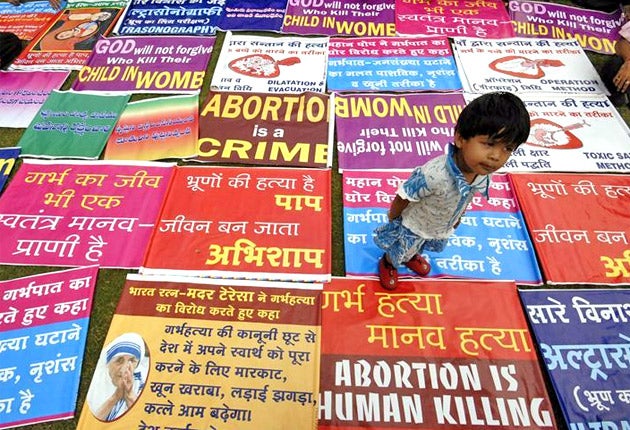The full extent of India's 'gendercide'
Its population is expanding at breakneck speed, yet its schools are empty of girls

Your support helps us to tell the story
From reproductive rights to climate change to Big Tech, The Independent is on the ground when the story is developing. Whether it's investigating the financials of Elon Musk's pro-Trump PAC or producing our latest documentary, 'The A Word', which shines a light on the American women fighting for reproductive rights, we know how important it is to parse out the facts from the messaging.
At such a critical moment in US history, we need reporters on the ground. Your donation allows us to keep sending journalists to speak to both sides of the story.
The Independent is trusted by Americans across the entire political spectrum. And unlike many other quality news outlets, we choose not to lock Americans out of our reporting and analysis with paywalls. We believe quality journalism should be available to everyone, paid for by those who can afford it.
Your support makes all the difference.Some call it India's "gendercide". In the past three decades up to 12 million unborn girls have been deliberately aborted by Indian parents determined to ensure they have a male heir.
Once, parents desperate for a son achieved the same end by infanticide. But modern medical technology, and the complicity of the medical establishment, has sanitised the process and made it more socially acceptable.
The systematic elimination of female foetuses in the world's biggest democracy is widening the gap between girls and boys and storing up social problems for the future. In some towns there is already a shortage of brides and there are fears the growing gender imbalance will worsen attitudes to women.
The 2011 census revealed 7.1 million fewer girls than boys aged under seven, up from 6 million in 2001 and from 4.2 million in 1991. The sex ratio in the age group is now 915 girls to 1,000 boys, the lowest since records began in 1961.
Latest research shows selective abortion is concentrated in families where the first child has been a girl. Parents welcome a first daughter but want their second child to be a son. In these families the gender ratio for second births fell from 906 girls per 1,000 boys in 1990 to 836 in 2005, implying between 3.1 million and 6 million female foetuses have been aborted in the past decade.
Wealthier, better-educated couples are the worst offenders, the findings show, putting paid to hopes that socio-economic progress would lead to a change in attitude. Although all strata of Indian society share a preference for sons, better-off families have access to and can afford the ultrasound tests to reveal the sex of a foetus.
Couples believe their family is unbalanced without a son who will continue the family name, earn money, look after his relatives and take care of his parents in old age in a country which has no social security system. Importantly, a girl will marry out of her family, taking her dowry with her, while a boy will bring a dowry into the family, a significant economic advantage.
Publishing his findings in the journal The Lancet, Professor Prabhat Jha of the Centre for Global Health Research at the University of Toronto, and colleagues from India, said: "The selective abortion of female foetuses, usually after a first-born girl, has increased in India over the past few decades, and has contributed to a widening imbalance in the child sex ratio." They call for closer monitoring to help curb the "remarkable growth of selective abortion of girls".
Termination of pregnancy on the basis of sex was made illegal in India under the Pre-Natal Diagnostic Techniques Act in 1996, but the law is routinely flouted. The Home Secretary, Gopal Pillai, has called for a "complete review" of the current policies designed to deal with the imbalance in the sexes, but few believe there is a genuine willingness among politicians to address the issue.
The market for sex determination is said to be worth at least $100m (£62m) a year, with 40,000 registered ultrasound clinics. Although attempts have been made to increase penalties under the act, out of 800 court cases against doctors in 17 states there have been only 55 convictions.
In a commentary published alongside the paper, Dr S V Subramanian of the Harvard School of Public Health, said: "The demand for sons among wealthy parents is being satisfied by the medical community through the provision of illegal services of sex-selective abortion. The financial incentive for physicians to undertake this activity seems to be far greater than the penalties associated with breaking the law."
Efforts to reduce discrimination against girl babies have been successful in places such as South Korea. But the sex bias found among second-borns recorded in India has also been found among Indians living in the USA, where the same social pressures do not exist.
"This finding raises a difficult and provocative question for public policy: should medical technology be allowed to play a part in letting a family plan their desired composition, especially when there is an active public policy effort to voluntarily limit family size to replacement level?" Dr Subramanian says.
Join our commenting forum
Join thought-provoking conversations, follow other Independent readers and see their replies
Comments